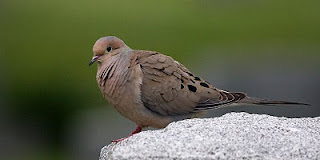Listen to the commentary
Real Audio : MP3 download
According to convention, detective stories begin with a dead body. But this one begins with a louse—a live louse. The trouble with this live louse? It was supposed to be dead, and not just sorry-he-just-couldn’t-pull-through, individual dead. This louse was supposed to be kaput as a species, absent from the face of the earth for nearly a hundred years.
The louse in question—whose status was even highlighted by his scientific name, Columbicola extinctus—was thought to have lived on only one host animal, the passenger pigeon. And the passenger pigeon’s time on earth ended with the demise of a bird named Martha at the Cincinnati Zoo, all the way back in 1914.
 So what was Columbicola extinctus doing—very much alive—on another species of bird, the band-tailed pigeon, which occupies territory from Alaska to South America, on the eve of the twenty-first century?
So what was Columbicola extinctus doing—very much alive—on another species of bird, the band-tailed pigeon, which occupies territory from Alaska to South America, on the eve of the twenty-first century? That’s what Kevin Johnson wanted to know.
Johnson (pictured with museum specimen of a passenger pigeon, by L. Brian Stauffer) is currently an ornithologist with the Illinois Natural History Survey at the University of Illinois who studies the relationships between parasites, such as lice, and their bird hosts. But back at the time Columbicola extinctus was brought back from the dead, so to speak, he was working as a postdoctoral researcher at the University of Utah with one of the scientists who made the discovery.
The natural way to answer the question of why a louse that’s thought to be specific to one host is unexpectedly found on another is to look at how closely those host animals are related.
 Previously, passenger pigeons had been thought to be most closely related to mourning doves, which are the doves you’re likely to know from seeing them in your yard. [Photo by author.] This association was based on shared physical characteristics, similarities in the coloring of their feathers and the length of their tails.
Previously, passenger pigeons had been thought to be most closely related to mourning doves, which are the doves you’re likely to know from seeing them in your yard. [Photo by author.] This association was based on shared physical characteristics, similarities in the coloring of their feathers and the length of their tails.What Johnson set out to do, in cooperation with three colleagues from around the country, was establish how passenger pigeons were related to other species of pigeons and doves in terms of their genetic makeup.
I’d like to be able to portray the lab work and analysis they did as sexy and exciting, the way it is on CSI, but that’s beyond me as a writer. So I’ll give you the short version. Johnson and his colleagues compared genetic material from a museum specimen of a passenger pigeon with genetic material from 78 other species of pigeons and doves, a representative selection of the more than 300 species that occur worldwide today.
Using what they learned by comparing that genetic material, they constructed a revised evolutionary family tree for pigeons and doves, published as a scientific paper this year, which shows how far back you have to look to find ancestors that are shared by modern species.
 On this tree, the now-extinct passenger pigeon occupies a branch much closer to the band-tailed pigeon than the mourning dove. So the louse, Columbicola extinctus, had gone on living after the demise of the passenger pigeon because the passenger pigeon was survived by an evolutionary cousin, the band-tailed pigeon. [USFWS photo by Gary Kramer.] And that cousin is also a suitable host for extinctus.
On this tree, the now-extinct passenger pigeon occupies a branch much closer to the band-tailed pigeon than the mourning dove. So the louse, Columbicola extinctus, had gone on living after the demise of the passenger pigeon because the passenger pigeon was survived by an evolutionary cousin, the band-tailed pigeon. [USFWS photo by Gary Kramer.] And that cousin is also a suitable host for extinctus.As we close the case of the louse that turned out not to be extinct, I realize I’ve said almost nothing about the life and death of the passenger pigeon as a species. So tune in next week for that story.




